The man-made, rain-fed lake Sukhna, located in Sector-1, Chandigarh, was built in 1958 at the cost of Rs 1 crore by damming Sukhna rivulet. Over the years, the lake has become integral part of Chandigarh’s cultural life and recreational activities. At the same time, ever since its creation, it is also in the centre of natural and man-made problems.
For years, pursuing Punjab & Haryana High Court (HC), Chandigarh directives, Union Territory Administration Chandigarh (UTAC), has been taking several measures to restore the lake’s falling glory. However siltation, catchment degradation, water evaporation, weeds infestation, lack of rain, pollution all seems to have become persistent threats jeopardizing the lake eco-system.
All through the year 2017, the lake remained in news for various reasons. UTAC has pumped ground water to fill the dry lake. There are plans to transfer Bhakhra dam water to keep the lake saturated during lean season. HC Judges have visited places around the lake to observe progress on ground of its orders issued to revive the lake. The court has also cancelled a Tata Group real estate project proposed in Lake Catchment in violation of norms. Despite all this, the gradual deterioration of lake eco-system is going on. Here we try to capture various developments in 2017 regarding Sukhna lake.
About Sukhna Lake Sukhna (30°44′N 76°49′E) lake at Shivalik foothills has 3 sq km area. Its catchment area is 42.07 sq km, mostly under Mohali and Panchkula districts. In 1958, Le Corbusier the French Architect and Chief Engineer P L Verma created the lake by damming the Sukhna Choe, which is formed by a network of other smaller rivulets like Ghareri, Nepali, Nathewala and Kansal. https://en.wikipedia.org/wiki/Sukhna_Lake The Sukhna river is a tributary of Ghaggar basin.
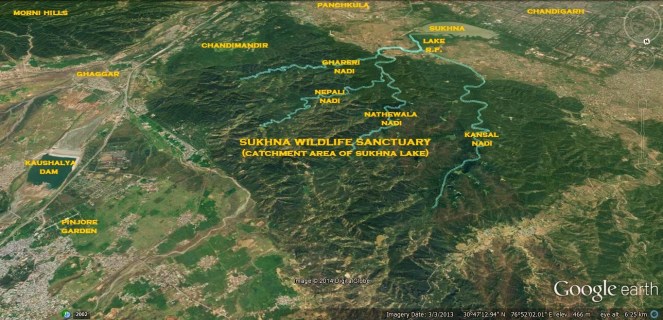
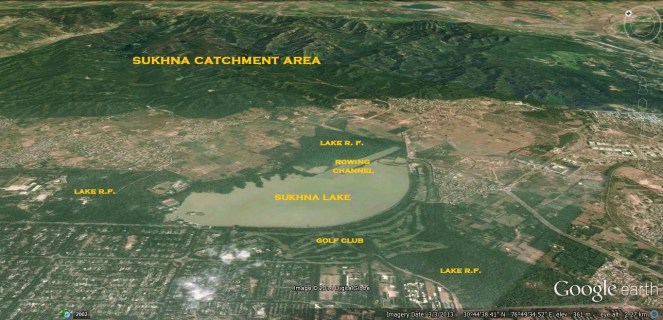
Importance of Sukhna
Over the years, Sukhna lake area has become an inseparable part of the city. The lake is well connected with Rock Garden and Golf Course. The 1.5 km long embankment of the lake is serving as public walkway. The lake is regularly visited by people from every walk and with different professional background like morning walkers, bird watchers, athletes, painters, photographers. Also see, 21 Things To Do At Sukhna

It has the longest rowing channel in Asia. Many water sports like water surfing, skiing and sculling, boating, rowing, kayaking are regularly organized here. From time-to-time, social, and cultural festival are also held inside lake premises. The lake has generated so much attraction and emotions that citizens have been voluntarily campaigning and contributing for its desiltation on annual basis. https://en.wikipedia.org/wiki/Sukhna_Lake
During winters, the lake turns into a sanctuary for migratory birds. The lake supports around 30 species of resident birds. Given the rich bio diversity of Sukhna lake has been declared Wetland of National Importance in 1988 by Government of India. More than 40 per cent of Chandigarh’s geographical area is under forest cover which is mainly in and around Sukhna lake. http://chandigarh.gov.in/dept_forest.htm
Sukhna Lake is the main water source for fisheries in Chandigarh. The Fisheries Department Fish-seed Farm just off Sukhna Lake produces 6.5 lakh fish seed annually. These fish are stocked in Sukhna Lake, and in village ponds and ponds. In 1996 the department began producing fish-seed of ornamental species. The department conducts an annual Angling Competition at Sukhna Lake. http://chandigarh.gov.in/dept_fish.htm
Pumping Groundwater into Sukhna Failed to keep it Alive
In January 2017, UTAC decided to supply water from 7 tubewells to fill the Sukhna Lake from January 15, 2017. The quantity of water to be put into the lake (2 MGD – Million Gallons per Day) usually catered to 14,000 households or around 70,000 people. Interestingly, the city already faces a water shortage of 29 MGD.
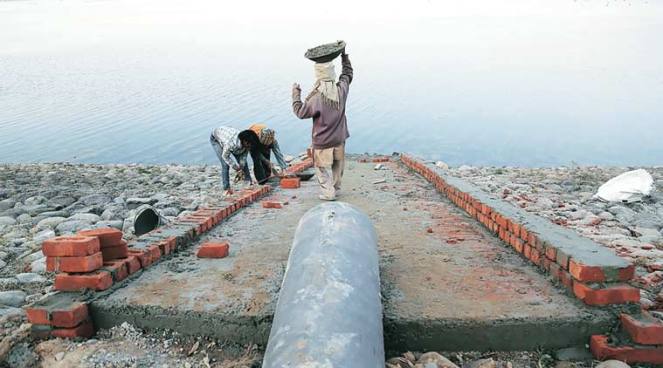
Referring to the National Institute of Hydrology (NIH), Roorkee study, the report further revealed that one of the major reasons for the loss of water in the lake is evaporation. Poor rainfall also led to the low water level. The water-holding capacity of the lake has also drastically reduced due to sand deposits says the report. https://www.hindustantimes.com/punjab/ut-admn-to-fill-sukhna-lake-with-7-tubewells-from-jan-15-diverting-supply-from-seven-sectors/story-LspHkfQkQXErlMyJKP3MBJ.html (Hindustan Times, 3 January 2017)

Accordingly 2 MGD using a 450 m pipeline was diverted from the supply of Sectors 19, 20 and 26-30. Previously, these tubewells were supplying water to the Sector-26 pumping station from where it was supplied to these sectors.
The project was inaugurated by Member of Parliament (MP) Kirron Kher on 16 January 2017 by breaking six coconuts at the pipeline. She was accompanied by HC judges, UT Chief Engineer (CE) Mukesh Anand and senior officers of the Public Health department.
Inauguration of Groundwater pumping in Sukhna lake (Image Sources: Chandigarh Metro & Daily Post)
Notably, Director Environment Santosh Kumar had said that it had been ensured that the drinking water supply demand of the city would not be disturbed. The step was reportedly taken after the tertiary treated sewage water supply to the lake was stopped for failing to meet permissible oxygen parameter. As per report, various other aspects of feeding water into Sukhna Lake were studied like diverting water from Patiali Ki Rao, a seasonal rivulet, water from tertiary plant, diverting rivulet water from Rajjipur confluence point at Surajpur, Pinjore. https://dailypost.in/news/chandigarh/mp-releases-tubewell-water-supply-sukhna-lake/ (Daily Post, 17 January 2018)
All the tubewells are reported to be located near the lake. The total cost of the project is stated to be around Rs. 45 Lakh including approximate Rs. 3.5 lakh per month as maintenance cost of 7 tubewells. The entire exercise was done to raise the water level by nearly 3 feet by March end.
Although, the city is already facing shortage of water to the extent of 29 MGD, the UTAC decided to divert the water to Sukhna. The decision was taken after the HC asked the UTAC to look for solutions to increase the level of water in the Sukhna.

Meanwhile, there was Public Interest Litigation (PIL) by a citizen Dr. Deepti, filed in HC for restraining the authorities from diverting drinking water to fill the lake and for evolving other sources for the purpose. But the the division bench comprising Justices AK Mittal and Ramendra Jain citing lack of necessary documents in the PIL, asked the petitioner to withdraw it and file fresh one if she wanted to pursue it. Directing the UTAC as well as the Municipal Corporation to continue their efforts to restore the lake, the HC also made it clear that the authorities were bound to ensure adequate drinking water supply to the city residents. https://chandigarhmetro.com/sukhna-lake-gets-water-supply-chandigarh-7-tubewells/ (Chandigarh Metro, 18 January 2017)
The Court had taken suo motu notice of the depletion of the water level in the Sukhna Lake in 2009 and has been monitoring the case since then. During a hearing of the case, Chandigarh’s senior standing counsel Suvir Sehgal submitted that after pumping water regularly from seven tubewells since January 16, the Sukhna Lake’s water level has increased and is expected to go up further by around six inches in a month.
However, the court directed that the authorities, after taking into consideration the suggestions received from the general public, should endeavour to explore other means to maintain the desired water level of the lake. http://indianexpress.com/article/cities/chandigarh/ensure-restoration-of-the-sukhna-lake-high-court/ (The Indian Express, 4 February 2017) To know more about the Lake and the problems it is facing, see the link
Showing 0.30 feet rise in lake water level, The Tribune report quoted a senior UTAC official, saying that on January 17, when MP Kirron Kher started the project to pump water through tubewells into the lake, the water level at Sukhna was 1154.10 feet (above mean sea level), which has now increased to 1154.40 feet. Besides the tubewell supply, there was good rainfall which also helped in increasing the water level of the lake, he said. http://www.tribuneindia.com/news/chandigarh/community/after-supply-from-tubewells-water-level-rises-in-sukhna-lake/358865.html (The Tribune, 03 February 2017)
Contrary to this, Hindustan Times report writes that there was no significant improvement in the water level even after passing of one month since the lake was being filled with groundwater. As per the report, before pumping water, the level was 1,154 feet against the required 1,163 feet, and on February 12, 2017 the level was still at 1,154 feet against the UTAC claim of a rise of 6-7 inches by the project. As per the report, UTAC had already spent Rs 4 lakh in the past one month and even reduced the supply to Sectors 19, 20, 26 to 30 by 2 MGD.

UTAC Chief Engineer, Mukesh Anand, confirmed that after rise in initial days the water level had not increased as tube well did not pump water for four days on account of water scarcity in the city. He also cited evaporation as a reason behind the phenomena.
MC Jindal, a retired Regional Director, Central Ground Water Board, Chandigarh, also revealed that pumping ground water through tube wells into lake was not feasible and the best solution was to utilise Patiala ki Rao (seasonal rivulet) water during monsoon period for the purpose. The water was presently diverted to parts of Punjab.
As per report, in late 1980’s, raw water used to be supplied from Sector 39 and 12 for irrigation purpose to northern sectors and during the Asian Rowing Championship in 1989, raw water connection was given to Sukhna Lake from pipeline already supplying the same to northern sectors. But, after the availability of tertiary treated water in 1990, this system of supplying raw water to northern sectors was discontinued. Now, water pipeline, which was earlier supplying raw water from Sector 39 water works, was supplying potable water. https://www.hindustantimes.com/punjab/7-tube-wells-pumping-water-but-sukhna-s-level-is-same-as-january-16/story-kcTIZmXEohrsRJoH2ZJwsM.html (Hindustan Times, 13 February 2017)
Meanwhile during February 17, hearing, Rajinder Singh Ahluwalia, Superintending Engineer (SE) Public Health Department (PHD) informed the Court that the UTAC was successful in increasing the lake’s water level by 4.8 inches.
As per the SE the lake water level on January 16 was 1,154.00 feet and by February 16, it had reached a level of 1154.40 feet. He also told the court that during this period the water could not be pumped into the lake for seven days for various reasons. Ahluwalia further added, “as per the log book maintained for the corresponding period (January and February) during the last year i.e. 2016, there was a loss of water to the extent of 5.4 inches due to normal percolation and evaporation of water.”
At the end of hearing, the court directed the authorities to carry out the continuous process of de-weeding from the lake as well as to focus on de-silting. The court also directed the authorities to go through the public suggestions to restore the beauty of Sukhna Lake. http://indianexpress.com/article/cities/chandigarh/sukhna-lake-water-level-went-up-by-4-8-inches-since-january-16-says-ut-administration-4530838/ (The Indian Express, 18 Feb 2017)
Another report in the same paper quoted officials of the engineering wing to say that the water of the lake was evaporating quickly due to soaring temperature. They also blamed the shutdown of water supply from the Kajauli waterworks for four days. The report mentioned that the lake was at a higher level than the tubewells making pumping of water to that level necessary. UTAC had constructed a pipeline between the lake and the tubewells for this purpose. http://indianexpress.com/article/cities/chandigarh/evaporation-sand-deposits-main-reasons-for-depleting-water-level-engineers-4530854/ (The Indian Express, 18 Feb 2017)
The Court had asked the UTAC to set up a committee and seek expert advice, despite that all it came up with is this proposal to fill the Lake with the help of tube wells. These tube wells are located in the golf course along the Lake which is also flanked by manicured gardens of the residences of Punjab and Haryana governors.
The Administration had earlier proposed to let treated sewage water flow into the river but the move came under sharp criticism from environmentalists. Even the move to fill the Lake with tube well water has been criticised by experts who termed it to be unwise to use ground water for the purpose. They also pointed out that the water table was already going down and residents would face shortage in summers.
Images by Indian Express Showing Groundwater being pumped in the lake and its level of water.
They also suggested that the check dams had served their purpose and should be dismantled to make way for water to the Lake. Recently, a suggestion was made to divert the waters of another rainfed river, Ghaghar, by a constructing a small channel.
As per the current plans of the Administration, it would keep pumping water from tube wells till March when the demand for water increases in the city. Some areas, particularly those in the south, face acute water shortage in summers even though the city is much better placed than others in the country as far as per capital availability of water is concerned. Drinking water supply is generally rationed during peak summers and due to low pressure, water often does not reach second or third floors. http://www.indialegallive.com/constitutional-law-news/special-report-news/sukhna-lake-deep-water-20013 (India Legal Live, 13 Feb 2017)
On 20 March 2017, the UTAC stopped the pumping of ground water to fill the lake citing the increasing drinking water requirement in the city. As per the report, there was no rise in the water table despite spending of Rs 45 lakh public money.
According to the daily monitoring committee of the UT Environment Department, the day-to-day water level observed at the Sukhna Lake and according to the report generated the water table in maintained between 1154.35 feet and 1154.40 feet. Thus pumping of precious ground water at the cost of potable water supply only turned to be maintaining the level and compensating for the evaporation losses during the two months.
Referring to NIH study, UT Environment Department Director Santosh Kumar stated that the 1.5 MGD of water fed into lake monthly was equivalent to the evaporation rate of 4 mm on daily basis. According to the calculations, the water from tubewells fed into the lake was 4 mm per day, hence the water fed was equal to the water evaporated on daily basis.
As per NIH study the water evaporation rate in the Sukhna Lake is 4 mm per day in the months of November, December, January and February, which will rise to 10 mm in March and in April, May and June the evaporation rate rises to 15 mm per day. https://dailypost.in/news/chandigarh/ut-stops-tubewell-water-sukhna-lake/ (Daily Post, 29 March 2017)
HC directed Panel on Sukhna Lake
Hearing the ‘Save Sukhna Lake’ case further, in April 2017, the Court asked UTAC whether it had formed a panel to devise a revival plan for Sukhna Lake. Interestingly, in August 2011, HC had directed the UTAC to constitute a panel with a senior official on board to look into the issues related to upkeep, revival and maintenance of the lake. The HC bench also observed that the only option now left was of waiting for the rains the dams and lakes are drying up as due to harsh summer.
The court was apprised by senior UTAC standing counsel Suvir Shegal that the Indian Institute of Technology (IIT), Roorkee, had agreed to survey the lake and examine the issue of bringing more water to it. He also said the the other proposals received from the tri-city residents on the lake revival were also being examined. https://www.hindustantimes.com/punjab/have-you-formed-panel-for-sukhna-revival-plan-hc-asks-chandigarh-administration/story-cLzTXNmRH7x2eckoP7D9PK.html (Hindustan Times, 20 April 2017)

Image & Information Source : The Tribune June 2012 report
During May 2017 hearing the Court asked Centre’s Ministry of Water Resources (MoWR) and Ministry of Environment and Forests (MoEF) to depute one official each for the May 22 hearing to apprise the court on steps needed to revive the lake.
The report also disclosed that following August 2011 order a panel headed by conservator of forests, UT, had nine members was formed. In April 2012, secretary, engineering was made the head of the panel and two more members were also increased. However the affidavit of the administration revealed that the committee has not met since April 2014. https://www.hindustantimes.com/punjab/hc-asks-centre-to-pitch-in-to-revive-sukhna-lake/story-gYCC6mcHgOgyh0tz3hvZFK.html (Hindustan Times, 2 May 2017)
Water Level Continue To Fall
In April with the beginning of summer, the Lake started drying up setting alarming bells ringing for UTAC. Theevaporation of water from the lake was reportedly happening at a fast pace with the city temperature having nearly touched the 40-degree mark.
The water level on April 14, came down to 1153.75 feet (from the sea level) on the scale. As per the report, the water level on the scale should not be confused with the lake’s depth which currently is not more than 2-3 feet in nearly half of its portion towards the rear side (regulator’s end) and 4-5 feet at the front side where boating is allowed.
It was in 2012 last when the lake got sufficient water from its catchment area after a good rainfall. While many put the blame on the construction of a number of check dams in the upper range of Sukhna, others are unhappy over an increased urbanisation in its catchment area, causing disturbance in the water bodies. To know more about siltation problem, please see this study. https://www.hindustantimes.com/punjab/two-weeks-into-summer-sukhna-lake-starts-drying-up-again/story-yKMUxI8jDG2xB80YVHexNL.html (Hindustan Times, 15 April 2017)
Image & Information source: Hindustan Times
Further, the water level on April 30 dipped to 1,153.30 feet. As per report if the water level goes down to 1151-foot mark, the entire lake bed will be visible in most of its parts hampering boating activities. When the scale touches 1163-feet mark, the authorities open the gates to move the surplus water out. Ideally, the lake’s depth should be 13 feet. https://www.hindustantimes.com/punjab/hc-asks-centre-to-pitch-in-to-revive-sukhna-lake/story-gYCC6mcHgOgyh0tz3hvZFK.html (Hindustan Times, 2 May 2017)
By middle of May 2017, more than 50 percent of the lake area turned dry. In just 6 decades, the area of the lake under water has shrunk by nearly 57 per cent. At the time of creation, in 1958, it was spread over an area of 3 sq km but in 2016, it was reduced to 1.3 sq km. Even at the end of the monsoon season, the water level stood at only 1,154 feet which further went down to 1,151 feet during lean months in 2016. http://indianewengland.com/2017/05/chandigarhs-sukhna-lake-goes-dry/ (India New England, 16 May 2017)

The rainfall has been deficient for past 6 years affecting the recharge of seasonal rivulets feeding the lake. Over 200 check dams have been constructed in the Sukhna choe and other rivulets, which feed the lake from the catchment areas of Haryana and Punjab over past 4 decades. https://www.darpanmagazine.com/news/interesting/chandigarhs-oncebeautiful-sukhna-lake-goes-dry-shrunk-by-57/ (Darpan Magazine, 16 May 2017)
The HC on May 22, 2017 asked the UTAC to act fast and urged Punjab, Haryana and Centre to pitch in to save the lake. The Central Government blamed UTAC for present condition of the lake and for not acting upon its 2013 plan. Later, the HC asked the UTAC to use the situation of no water in the lake and try to clear the silt as much as possible and sought a detailed plan by May 25.
“You have to do something, and that too on a war-footing. There is not much time left now,” the bench presided over by justice AK Mittal told UTAC. As per Chetan Mittal, Assistant Solicitor General the JCB machines to be used for dredging out mud cost Rs 80 lakh each, while tender was being given for Rs 4 crore. “It could have been done with two JCB machines each roped in from Punjab, Haryana and UT. Even within two weeks they could have made difference,” senior advocate, Rajiv Atma Ram said, who is the amicus curaie in the matter.
The HC also asked Punjab Haryana and Chandigarh to nominate a secretary level official, who would sit together and work on plan to save the lake. The HC bench also asked Centre to spearhead the campaign to save the lake. https://www.hindustantimes.com/punjab/sukhna-going-dry-it-s-now-or-never-hc-tells-chandigarh-administration/story-hspEGmWPGFKvZVgbSQPcmO.html (Hindustan Times, 23 May 2017)

The UTAC considered a plan to divert 2 MGD water from Bhakra mainline canal daily from Nov 1 to Feb 28 every year as a permanent solution to prevent the drying up of lake. As per report, it was additional water as UTAC was getting 62 MGD water from Bhakra mainline canal daily whereas the demand in winter for the city was 50 MGD.
The report also stated that rainfall only above 50 mm in a day can create significant run-off from hilly catchments areas and in 2016 in the entire monsoon, there were only two days when it rained above 50 mm. So far, the lowest post-monsoon water level recorded for the lake is 1,154.55 ft in 1987. Going by the recorded water levels of the last 3 decades, the UTAC says that the lake has “dried up” once every 4-5 years. Water has dipped below the red flag level of 1,157-1,158 feet several times since 1981. Whenever the post-monsoon level is below 1,157-1,158 feet, the lake usually dries up the next summer. http://indianexpress.com/article/chandigarh/ut-solution-for-sukhna-proposal-to-divert-2-mgd-water-from-bhakra-daily-4675881/ (The Indian Express, 27 May 2017)
In the same month, following the directions of HC, a high-powered committee comprising officials from UT, Punjab and Haryana and scientists from Central government ministries had a meeting to discuss the receding water level of Sukhna. During the meeting officers of both the states not only offered resources for de-weeding and de-silting of the lake but also agreed to share the water to fill the lake. RS Verma, Secretary, irrigation, Haryana, also proposed to bring water from the Bhakra by laying a separate pipeline. http://www.tribuneindia.com/news/chandigarh/good-sign-for-sukhna/414405.html (The Tribune, 29 May 2017)
As the ‘Save Sukhna’ case came up for resumed hearing before a Division Bench on 01 June, Haryana Government assured the HC of blocking the flow of silt and sewage into Sukhna Lake. It also informed the court on the six-member committee (constituted in the ‘Save Sukhna’ case) meeting held on May 31, at the UT Guesthouse for submitting suggestions. http://www.tribuneindia.com/news/chandigarh/game-for-saving-sukhna-haryana/416334.html (The Tribune, 1 June 2017)

In June 2017, hearing a separate dispute between UTAC and Chandigarh Golf Club a different bench of HC asked the UT administration why the tertiary water cannot be used to fill Sukhna Lake, facing ‘extinction’. Later it asked UTAC to find out how much tertiary water was being generated in the city, capacity to treat that water and the quantity of water supplied to the club for watering the 61 acres of green belt. As per report, UTAC had finalised the tender for de-silting of lake for ₹20 lakh but work was not started. http://www.hindustantimes.com/punjab/why-can-t-tertiary-water-be-used-to-fill-sukhna-lake/story-TMv606WrfCvDYh66App9uI.html (Hindustan Times, 18 June 2017)
In Sept, following good rainfall, the water level in the lake reached 1161.52 ft and it was expected to rise further with prediction of more rain. In 2016, the highest water level was recorded at 1158 ft. The highest level in last 10 years has been 1163.95 ft recorded in 2008.
As per report, at the time of creation, the lake had a storage capacity of 10.47 million cubic metre (mcm) and water spread area varying between 1.52 sq km and 2.28 sqkm. Between 1958 and 1962, the lake lost more than 20 per cent of its capacity due to heavy silting. https://timesofindia.indiatimes.com/city/chandigarh/sukhna-water-level-witness-rise-to-1161ft/articleshow/60330506.cms (The Times of India, 5 September 2017)
In 2017, Chandigarh has received close to 800 mm of rainfall which has helped Sukhna Lake reach the 1162 feet mark. Following this, the UTAC decided not to use water of tubewells to fill the lake during the winter season.
To maintain the water level of the lake, the authorities have also explored the possibility of using treated tertiary water. The Chandigarh municipal corporation treats around 30 MGD, of which around 10 MGD is being used by the city residents for irrigation. The civic body spends about Rs 1 crore every year on treating waste water. https://timesofindia.indiatimes.com/city/chandigarh/sukhnas-water-level-goes-up-ut-dept-says-wont-use-tubewell-water-this-year/articleshow/61230292.cms (The Times of India, 20 Oct 2017)
Plan To Maintain Lake Water Level With Treated Sewage Water
In August 2017, UTAC planned to set up a 2-MGD sewage treatment plant (STP). Besides, another STP of 2-MGD capacity was planned at Maloya. Both plants would cost more than Rs 50 crore and would be installed under the public private partnership (PPP) mode. As per report, around 2 MGD of sewage generated by Kishangarh was daily discharged into a Choe which can be fully utilised by the proposed plant.
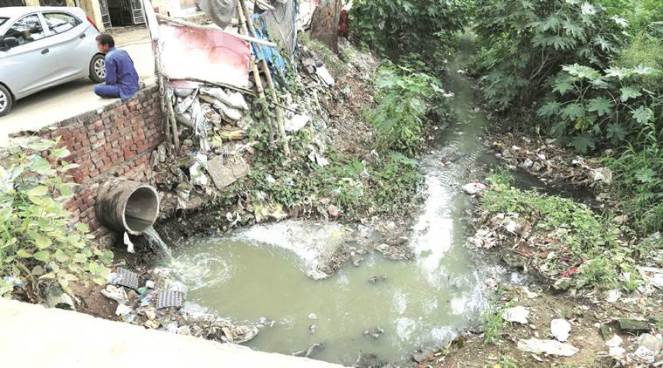
The idea for using treated water came after Special Secretary (Engineering) Mukesh Anand and UT Director (Environment) Santosh Kumar recently visited Delhi to see such treatment plants. The authorities, in August 2017 had shortlisted a Delhi based firm to install the STP plant at Kishangarh on a trial basis. http://www.tribuneindia.com/news/chandigarh/ut-to-fill-sukhna-with-treated-sewage/504230.html (The Tribune, 27 Nov 2017), https://timesofindia.indiatimes.com/city/chandigarh/ut-plans-to-fill-sukhna-with-treated-sewage-water/articleshow/60137876.cms (The Times of India, 20 Aug 2017)
In Dec 2017, the proposal for the installation a STP was finalised and approved by the UTAC. Responding to the pleas of amicus curie Tanu Bedi that the sewage water may not be allowed to be mixed with the lake water without court permission, the HC allowed UTAC to continue with the process but to take the court into confidence before pumping treated water into the lake.
As per report detailed parameters of the treated sewage have been finalised by committee of five officers, including one from the Chandigarh Pollution Control Committee (CPCB). The HC, in its order dated March 14, 2011, had also issued directions for restoring the lake and its former glory. http://www.tribuneindia.com/news/chandigarh/ut-finalises-proposal-for-installing-stp/516112.html (The Tribune 19 December 2017)
Pollution Of Lakes Increasing, Aquatic Life Under Threat
The aquatic life in the lake is under threats of past many years. In August 2017, there were reports of fish death in the Dhanas and Sukhna lake due to lethal combination of high humidity, low cloud cover and pollutants causing lack of oxygen in water bodies. As per 2015 report, the monsoon drains feeding into the lake from the Kaimbawala-Saketri axis have turned into a death trap for breeding fish as the poaching mafia from nearby Bapu Dham colony and other slum settlements is using gillnets and even nets that stretch across the narrow drains. Fish deaths were also reported in the lake in Dec 2014, Jan 2013 due to weed infestation, siltation and high water temperature. In 2008, 30 dead fish were found in the lake. At that time, formation of methane gas from decay of organic matter deposited in the lake bed, warm temperature and silt were cited a reasons behind the incident.
According to report, though the UTAC stopped the flow of sewage into Sukhna Lake from Kaimbwala village under HC directions, but it has been unable to prevent PGI from allegedly similarly draining wastes into Dhanas lake. The HC also directed the Haryana govt to stop Saketri village’s sewage from entering Sukhna Lake. https://timesofindia.indiatimes.com/city/chandigarh/pollutants-kill-fish-at-dhanas-sukhna-lakes/articleshow/60149020.cms (The Times of India, 21 Aug 2017)

In June 2017, UTAC wrote a letter to the Punjab Government to make arrangements to stop the flow of sewage from the Kansal area in Punjab into the Sukhna Lake. As per experts the sewage inflow was the reason behind weed problem in the lake. In past too, UTAC had written a letter to the Punjab Government, yet the issue remained unsolved. As per report, five types of weeds — pvallisneria spiralis, potamogeton crispus, hydrilla, ceratophyllum and typia — were growing in the Lake. http://www.tribuneindia.com/news/chandigarh/community/sewage-in-sukhna-worries-ut/99529.html (The Tribune 27 June 2017)
In Sept 2017, Justice AK Mittal and Justice Amit Rawal of HC directed officers of Haryana to take immediate steps to stop flow of sewage from Saketri to Sukhna Lake. The Judges, along with officers of the UTAC, Haryana and Punjab also visited the lake. They also directed the officers to increase the workers engaged to remove lotus from the lake. In August 2016 also, two judges Justice Ajay Kumar Mittal and justice Ramendra Jain had visited the catchment area, sanctuary, the regulator end to take stock of ground situation. http://www.tribuneindia.com/news/chandigarh/stop-flow-of-sewage-from-saketri-to-sukhna-lake-hc-judges/461456.html (The Tribune, 3 Sept 2017)
As per a report there are 3 lakes in Chandigarh, Sukhna Lake, New Lake in Sector 42, Dhanas Lake located near sector 38. The latest State of the Environment Report released by the UTAC found high levels of organic matter that monopolise the oxygen, and affect aquatic life. http://indianexpress.com/article/chandigarh/three-water-bodies-have-high-levels-of-organic-matter-aquatic-life-in-danger-ut-report-4993654/ (The Indian Express, 22 Dec 2017)
Fall In Number Of Birds Visiting The Lake
The number of migratory birds has also dropped drastically over the years. Nov. 2017 showed a marked fall in the number of birds visiting the lake, as only 696 birds of 91 species were spotted at the lake. This excluded many altitudinal migrants from Himalayas birds which visit the lake in following months. However The number of water fowl is stated to be comparatively lesser than earlier years. The second part of bird census is conducted in Feb to find out the exact number for the season. https://timesofindia.indiatimes.com/city/chandigarh/fall-in-number-of-winged-visitors-at-the-sukhna/articleshow/61619990.cms (The Times of India, 13 Nov. 2017)
Latest report reveals that about 1500 birds were counted at the lake in January 2018 a sharp fall in comparison to over 4000 last year. Surprisingly, the water level at the lake was reported at 1,160 metre in Nov 2017, as compared to 1,155 metre the previous year.

At the onset of last winter in Nov 2016, 1,086 birds of 53 species flocked the lake. While the number rose to 4,127 by Feb. 2017, but this year there has be visible decline. Authority blames high water level for this but regular bird watchers hold dredging of two islands in the lake main reason for this apart from loud music and noise in lake vicinity. https://www.hindustantimes.com/punjab/birds-eye-view-winged-visitors-count-waning-at-chandigarh-s-sukhna-sanctuary/story-o4H3AtIO2Ui9VkZcACT0tK.html (Hindustan Times, 15 January 2018)
It is worth to mention that in a first a Lesser Fish eagle has been seen visiting the lake in November 2017. Similarly in January 2014, River Tern (Sterna aurantia) a nearly threatened bird species rarely found in North India was seen at Sukhna lake.
High Court Action against Encroachment In Catchment
In a major setback to the investors of Tata Camelot Housing Project, the Delhi HC on April 12 held that the project cannot be allowed as it was well within the catchment area of Sukhna Lake in Chandigarh. (See the full order here and a detailed Economic & Political Weekly report on this here)
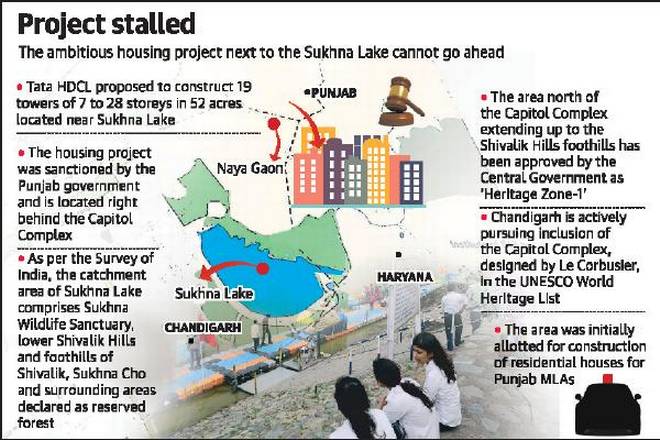
A bench of Chief Justice G Rohini and Justice Rajiv Sahai Endlaw said the permission for the project, which was granted by the gram panchayat of Sukhna catchment area village and endorsed by the Punjab government, is set aside. It also set aside environmental clearances given by the authorities concerned for the project.
The HC order came on a plea filed by advocate Aalok Jagga against the grant of approval by various authorities to the Tata housing project near Sukhna Lake. The apex court had earlier stayed the ambitious housing project by reversing the go-ahead granted to it by the Punjab and Haryana HC, the Supreme Court had transferred the plea to the Delhi High Court and asked it to decide the matter.
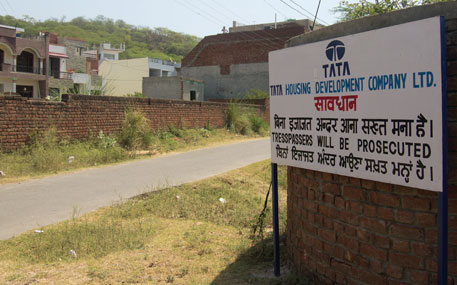
TATA Camelot is a Rs 1,800-crore building project having 92,100 flats in 19 towers, ranging between 12 and 35 storeys and is slated to be raised on 53.39 acres of land near the Chandigarh Capitol Complex. The project allegedly falls in the catchment area of Sukhna Lake in the Union Territory of Chandigarh. http://www.business-standard.com/article/pti-stories/hc-s-no-to-tata-housing-project-near-sukhna-lake-in-chandigarh-117041200831_1.html (Business Standard 12 April 2017)
Meanwhile there is a report mentioning that UTAC could not publicize the HC May 2012 order and could be made to pay monitory compensation for encroachments razed down. The development took place during the hearing of a contempt petition filed by a city resident, who had alleged that construction activity was going on unabated despite court orders of May 2012.
Meanwhile, Punjab’s special secretary, local bodies, KK Yadav, who was present in the court, informed that a fresh survey had been conducted and about 80 illegal constructions identified. He said notice were issued to the persons concerned, and the promised action was followed by a compliance report. https://www.hindustantimes.com/punjab/ut-admn-may-have-to-compensate-encroachers-in-sukhna-lake-catchment/story-ByCrpB86OzvAD0hPLu7UMN.html (Hindustan Times, 30 May 2017)
In July 2017, the enforcement wing of the UTAC estate office razed around 80 illegal structures in Kaimbwala falling in the catchment area of Sukhna Lake amid protest and mild stone-pelting that left three officials injured. As per report, the next in the list was Khuda Ali Sher where around 200 illegal structures had come in catchment area of the lake.
The HC in May 2012 had imposed a ban on new construction in the catchment area of Sukhna Lake, which includes Kaimbwala, Khuda Ali Sher, Kansal and Saketri. The administration had also issued a public notice making residents aware about the decision but the residents reported to be unaware of any such step. https://timesofindia.indiatimes.com/city/chandigarh/ut-estate-office-raze-80-illegal-structures/articleshow/59746567.cms (The Times of India, 25 July 2017)
Commercial Activities In The Lake
Le Corbusier had foreseen that the residents of the city would be drawn to Sukhna for the ‘care of the body and spirit’. To preserve its tranquility, Corbusier had insisted on two things: that it be forbidden for motor boats to circulate in the water, and for vehicular traffic to be prohibited on top of the dam. https://en.wikipedia.org/wiki/Sukhna_Lake

Contrary to this, the UTAC has also planned to start open air gymnasium in forest area behind Sukhna Lake at cost of Rs 2 crore of which 80% funds will be provided by the Union govt under the Nagar Van Udhyan Scheme and the rest of the cost will be borne by the UT administration. https://timesofindia.indiatimes.com/city/chandigarh/soon-sweat-it-out-in-rs-2-crore-open-air-gym-in-forest-behind-sukhna-lake/articleshow/58442882.cms (The Times of India, 30 April 2017)
Also, presently the Chandigarh Industrial Tourism Development Corp is reportedly operating 135 paddle boats, five shikaras and one cruise boat in the lake. It earns around Rs 4 lakh a week (Rs 50,000 on weekdays and Rs 70,000 on weekends. http://www.hindustantimes.com/punjab/chandigarh-s-sukhna-lake-likely-to-go-dry-by-june-30/story-0f88zYsgTLZ8VNsrGAoJ5K.html (Hindustan Times, 20 May 2017)
Compiled by Bhim Singh Rawat (bhim.sandrp@gmail.com)









One thought on “Chandigarh Wetlands Review 2017: Sukhna Lake Facing Multiple Problems”